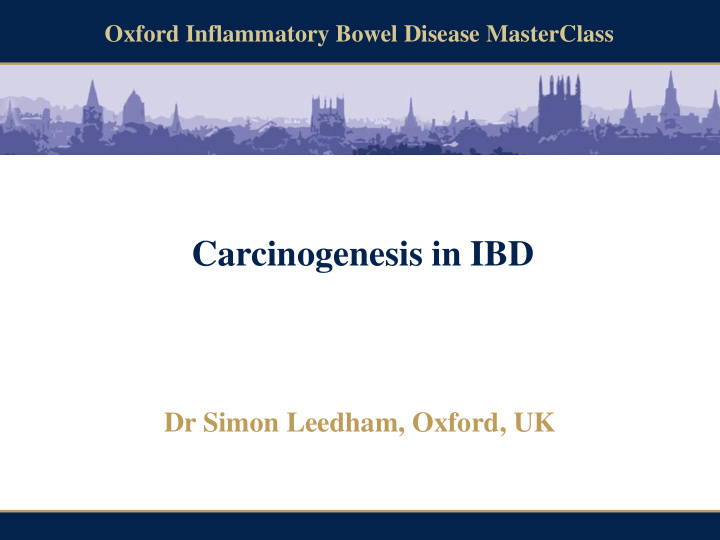



Oxford Inflammatory Bowel Disease MasterClass Carcinogenesis in IBD Dr Simon Leedham, Oxford, UK
Oxford Inflammatory Bowel Disease MasterClass Carcinogenesis in Inflammatory Bowel Disease Dr Simon Leedham Cancer Research UK Clinician Scientist Honorary Consultant Gastroenterologist University of Oxford
Pathogenesis of cancer in IBD Cell of origin Whats driving cancer forwards Genetic mutations Epigenetic change Mutation spread and field cancerisation Challenges and opportunities
Intestinal stem cells
Cell of origin
Cell of origin in cancer Apc KO in Lgr5 -ve cells Apc KO in Lgr5 +ve stem-cells Barker N, et al. Nature 2007;449:1003 – 07 Barker N, et al. Nature 2009;457:608 – 11
Tight morphogen regulation of stem cells Scoville D et al, Gastroenterology, 2008: 134(3), 849- 64
How does inflammation affect this balance? Chimeric Vil-CreERT: Rosa26R mouse (blue/white) Miyoshi H, et al. Science 2012;338:108 – 113
Cell of origin in inflammation driven cancer β -cat c.a. /Ikba ΔIEC Mouse Polarised morphogen expression disrupted by lamina propria inflammatory signalling De-differentiation and stem-cell plasticity Schwitalla S, et al. Cell 2013;152:25 – 38
Disrupted morphogen signalling
Carcinogen (e.g AOM) Inflammation (e.g DSS) Inflammation + Carcinogen Cooper H et. al, Acta Pharm, 2007 Carcinogen but treat inflammation Kirchberger S, et al. JEM, 2013
What drives IBD associated cancer Hanahan and Weinburg, Cell, 2000
APC and Wnt signalling
APC mutation frequency 9 0 8 7 8 0 7 0 6 0 5 0 % 4 0 3 0 2 0 1 7 1 0 0 Sporadic C olitis -as s oc iated
Sporadic adenomas Colitis associated dysplasia β -catenin staining Leedham et al, Gastroenterology, 2009
What is driving colitis associated carcinogenesis? Reactive oxygen and nitrogen species Telomere shortening and chromosomal end fusion NF-KB activation
Chromosomal instability Inflammation and repair provides the proliferative drive Chromosomal instability seen early - even in non- dysplastic tissue More seen in ‘cancer progressors’
Genetic mutations
So what genes are important in colitis neoplasia?
Genetic dependency analysis
Colitis associated gate-keeping mutations None found, 27% p53, 46% APC , 9% K-Ras, 18%
p53 as the commonest initiating mutation p53 – the guardian of the genome Tumours driven by chromosomal instability need to inactivate p53 to progress
The genetic road to cancer
Epigenetics Epigenetic changes
Methylation Normal Exon CpG methylated Promoter CpG islands unmethylated Age associated – widespread global change Cancer associated – tumour suppressor genes Promoter CpG hypermethylation Global hypomethylation
Methylation in sporadic cancer Sporadic serrated neoplasia pathway BRAF/KRAS mutation initiates Aberrant methylation detectable leading to CpG Island Methylator Phenotype (CIMP) Eventual methylation of TSG’s leads to rapid progression when dysplasia sets in Connection between genetic event (BRAF mutation and aberrant methylation unknown)
Methylation in colitis associated cancer Less CIMP panel positive lesions seen in CAC Inflammatory context alters the mediators of DNA methylation Methylation occurs as a response to inflammatory environment rather than a genetic insult Acceleration of age-related global methylation changes Colitis causes premature epigenetic aging of cells
Mesenchymal-epithelial interaction Methylation in stromal cells IL-6 stabilises DNA methyltransferase 1 DNMT1 expression higher in CAC than sporadic CRC samples Increased DNMT1 expression seen in both tumour and peritumoural stroma ?Altered DNA methylation in the mesenchyme affecting the malignant transformation of the epithelium Foran E et. Al, 2010, Molecular Cancer Res
Lesion spread
Lesion spread - Crypt fission in UC 60% of crypts in fission in active UC (Brittan, 2005) Main mechanism of epithelial restitution to heal ulcers FISH identifies abnormal chromosome 17 (p53) in the 2 halves of daughter crypts Chen et al, Carcinogenesis, 2005
Field Cancerisation - microscopically Leedham S, et al . Gastroenterology 2009;136:542 – 50
Widespread field cancerisation Galandiuk S, et al. Gastroenterology 2011;142:855 – 64
What can we learn from human tissue sampling? Single crypt gene expression analysis Single crypt mutation burden Organoid formation, clonogenic assays Multi-region biopsy and cancer heterogeneity
Key scientific challenges – input from the IBD physician Identifying the progressor from the non-progressor Histology is an incomplete gold standard when field cancerisation present Improved endoscopic targeting (dye spray, NBI, ?confocal) Molecular phenotyping, genetic risk stratification Fluorescent biomarkers (cf Barrett's esophagus 1 ) Intestinal inflammation and cancer Define the molecular pathogenesis Determining the cell of origin. Stem-cell plasticity in the human? Cancer progression in the biological therapy era – impact of mucosal healing as a therapy goal Personalising therapy Impact of sequencing technology Targeting the right pathway(s) The cancer heterogeneity problem 1. Bird-Lieberman EL, et al. Nat Med 2012;18:315 – 21
Acknowledgements Hayley Davis Shazia Irshad Stefania Segditsas Chiara Bardella Pedro Rodenas Cuadrado Lai Mun Wang James East Ian Tomlinson Collaborators Dan Worthley, Tim Wang, New York, USA Owen Sansom, Glasgow, UK Runjan Chetty, Toronto, Canada Jerry Shay, Dallas, USA
Recommend
More recommend